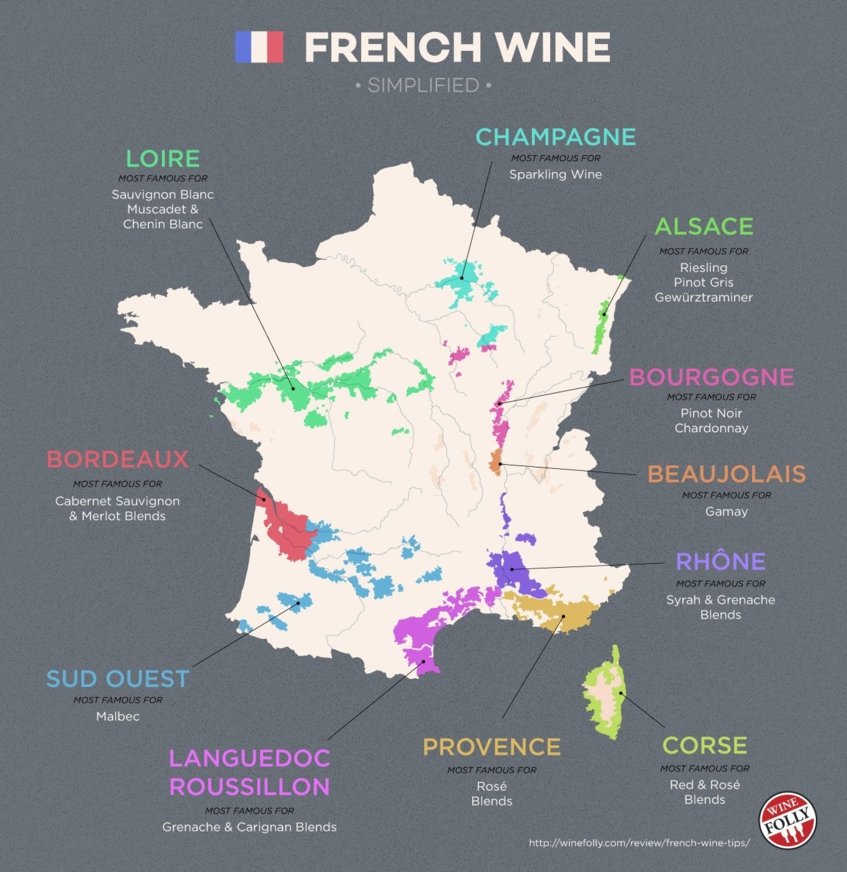While even the most elementary wine drinker will recognize the likes of Bordeaux, Burgundy and Champagne through their historic winemaking traditions, wines are commercially produced in every region of France except those along the north coast. Nonetheless, France produces over 3,000 different wines across two million hectares of vineyards – although, the country comes third behind leaders Spain and, more surprisingly, China in terms of the amount of land given to wine production.
Generally speaking, the French wine region's map can be divided into northern vineyards that are reputed for white wines, and southern vineyards (with the exception of the Jura and Savoy) that are more renowned for their reds. The main wine areas of the French wine region map are Bordeaux, Burgundy, Languedoc, Champagne, the Loire Valley, Alsace, Rhône, Provence and Corsica.
Bordeaux: the Wine Capital
Bordeaux on the Atlantic coast is among the most famous of wines. This region primarily produces red wines from world-renowned chateaux in the Medoc sub-region, Saint-Emilion and Pomerol. The wines made here are typically blends using Cabernet Sauvignon, Merlot and sometimes Cabernet Franc.
Burgundy, or ‘Bourgogne’, in the east is a region where red and white wines share equal prominence. Unlike others on the French wine region map, Burgundy places its greatest emphasis on ‘terroir’ in the production of two main grape varieties – Chardonnay for white wines, and Pinot Noir for the reds. The finest wines from the Côte d'Or are among the most prestigious, and expensive, in the world.
Champagne, which is situated close to Belgium and Luxembourg, is the most northern and coldest of the French wine regions, which together with chalky soils provide the ideal circumstances for creating its eponymous sparkling wine that now goes hand in hand with celebrations around the world.
The Loire Valley offers some of the most scenic vineyards found anywhere on a map of France wine regions, some accompanying the grounds of majestic castles. White wines dominate the area from dry Chenin Blanc wines to tangy Sauvignon Blancs and light Muscadets.
Côtes du Rhône is one of those wine regions that is arguably more renowned for the extent of its production than the quality of its wines, although it is home to the highly regarded Châteauneuf-du-Pape appellation. Most wines from here are generally Mediterranean blends using classic southern grapes including Viognier, Syrah, and Grenache.
Provence is located on the Mediterranean coast at the southern end of the Rhone Valley. Wine has been made here for over 2,600 years, making it the oldest destination on the French wine region's map – and it is the only region that dedicates almost all of its production to rose.
Alsace, nestled in the foothills of the Rhine valley beneath the Vosges mountains, is a region steeped in Germanic tradition that produces primarily dry and fruity white wines including Riesling, Sylvaner and Gewurztraminer. The Alsace wine route is one of the oldest and most picturesque trails enjoyed by wine travelers.
Languedoc-Roussillon is arguably the most underrated wine region in France, especially since it accounts for more than a third of the country’s entire wine output. Although once associated with mass production, the region has recently undergone a transformation to become firmly established on the map of France wine regions.
Corsica is an island in the Mediterranean under French rule, although its closeness to Tuscany suggests Italian origins that are apparent in its wines. It is one of the few places in the world that wines as diverse as Pinot Noir, Tempranillo and Barbarossa can be found growing together.
If you're interested in one of our France Wine Tours, please visit this link.
Map: Wine Folly.com





.png)




